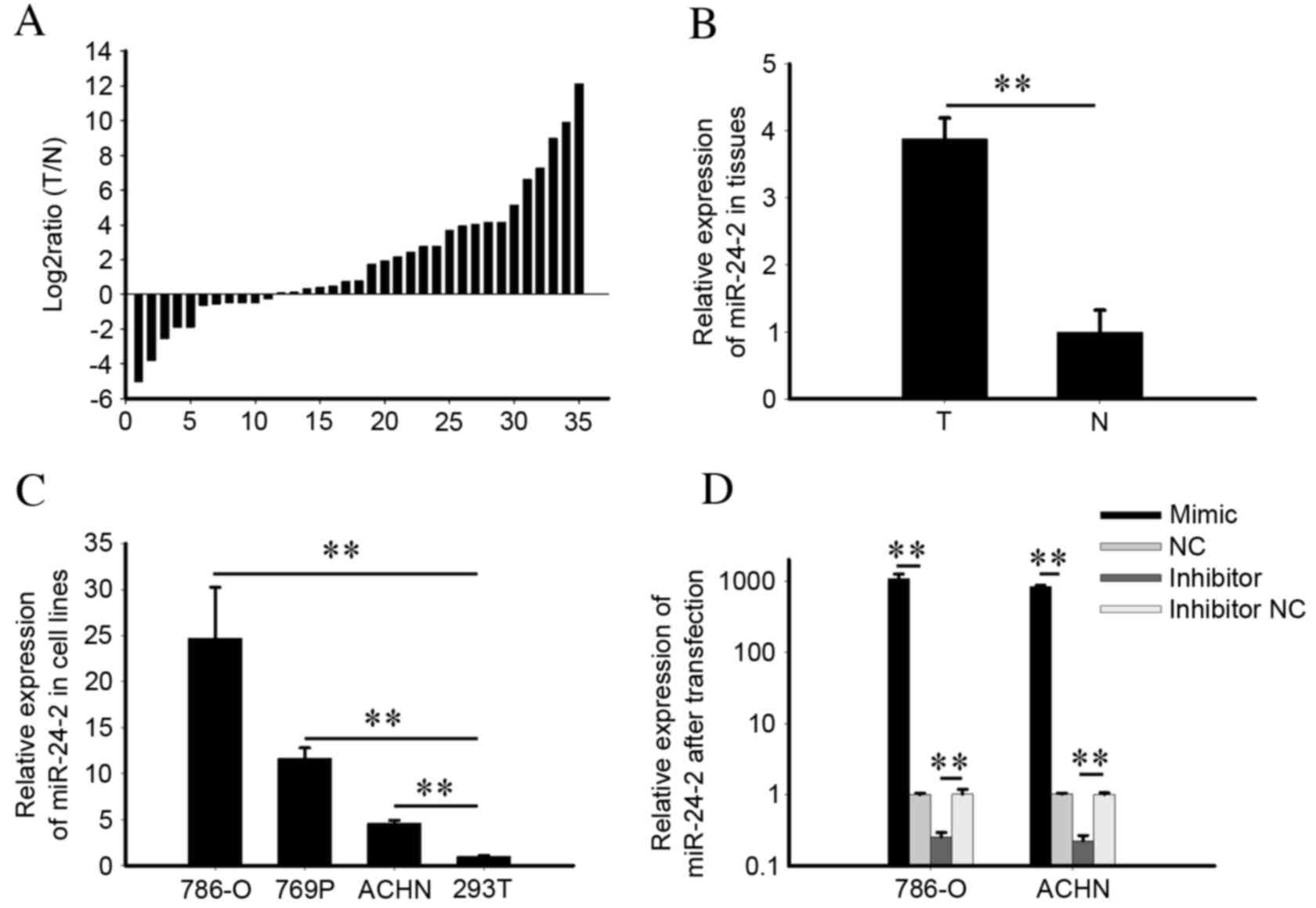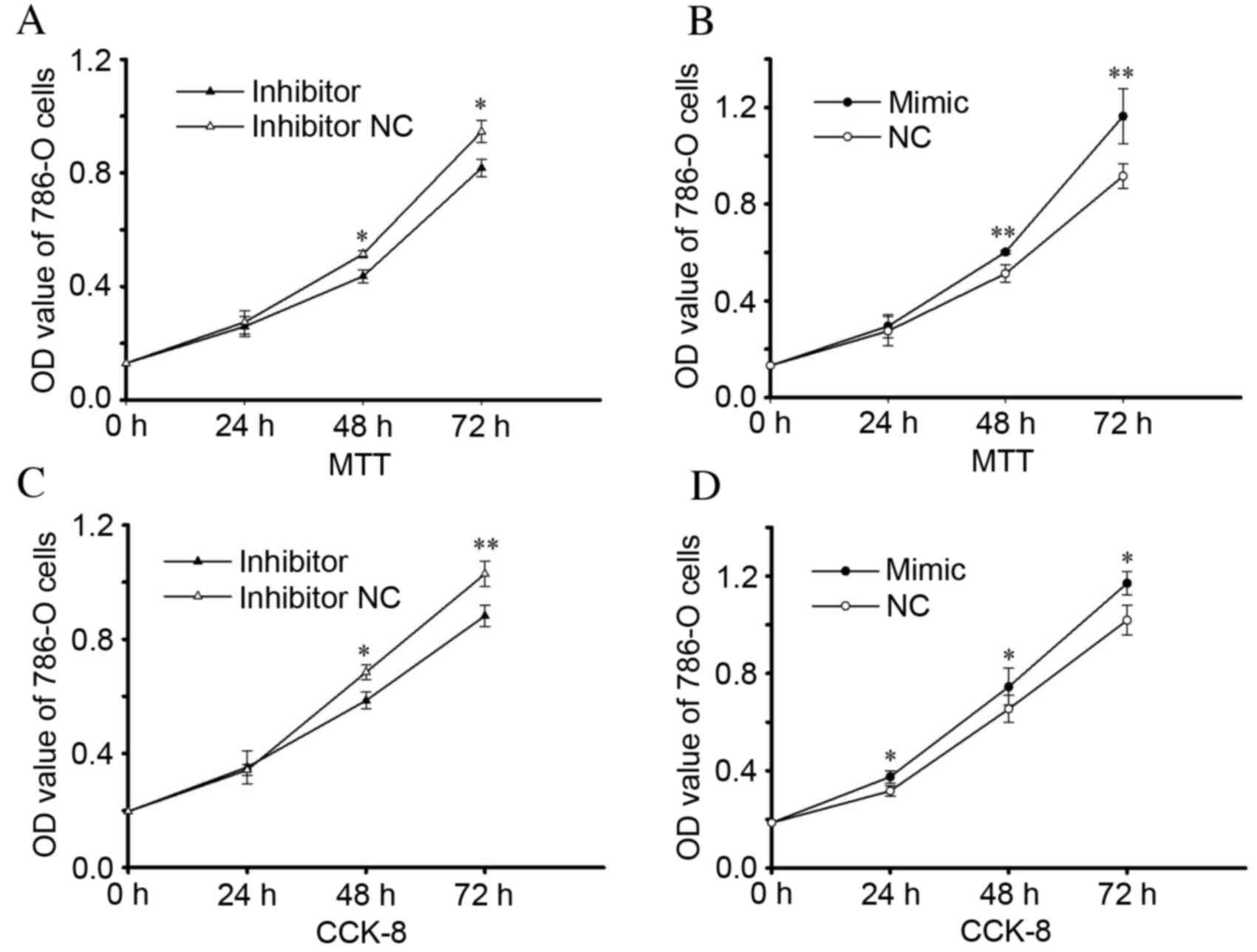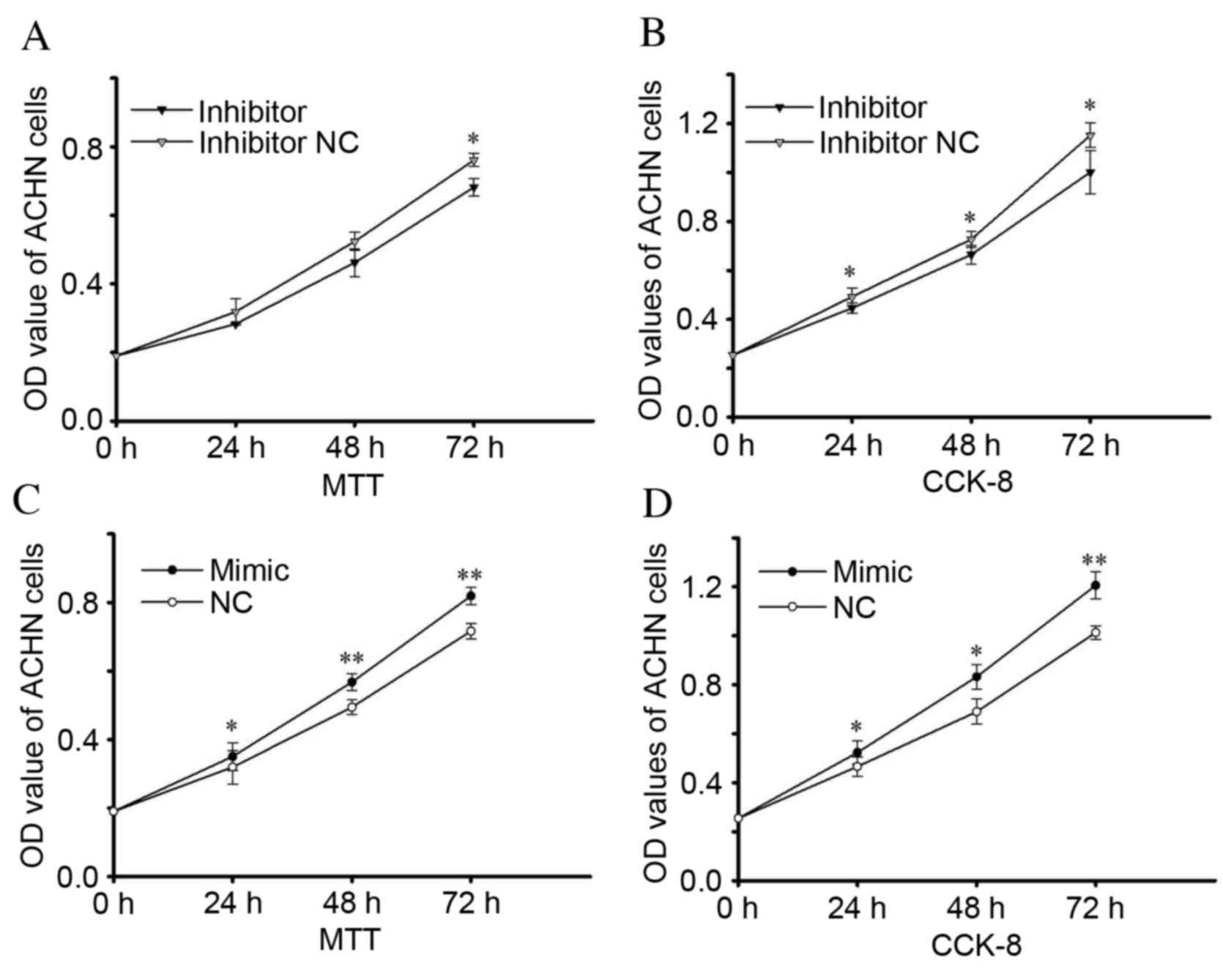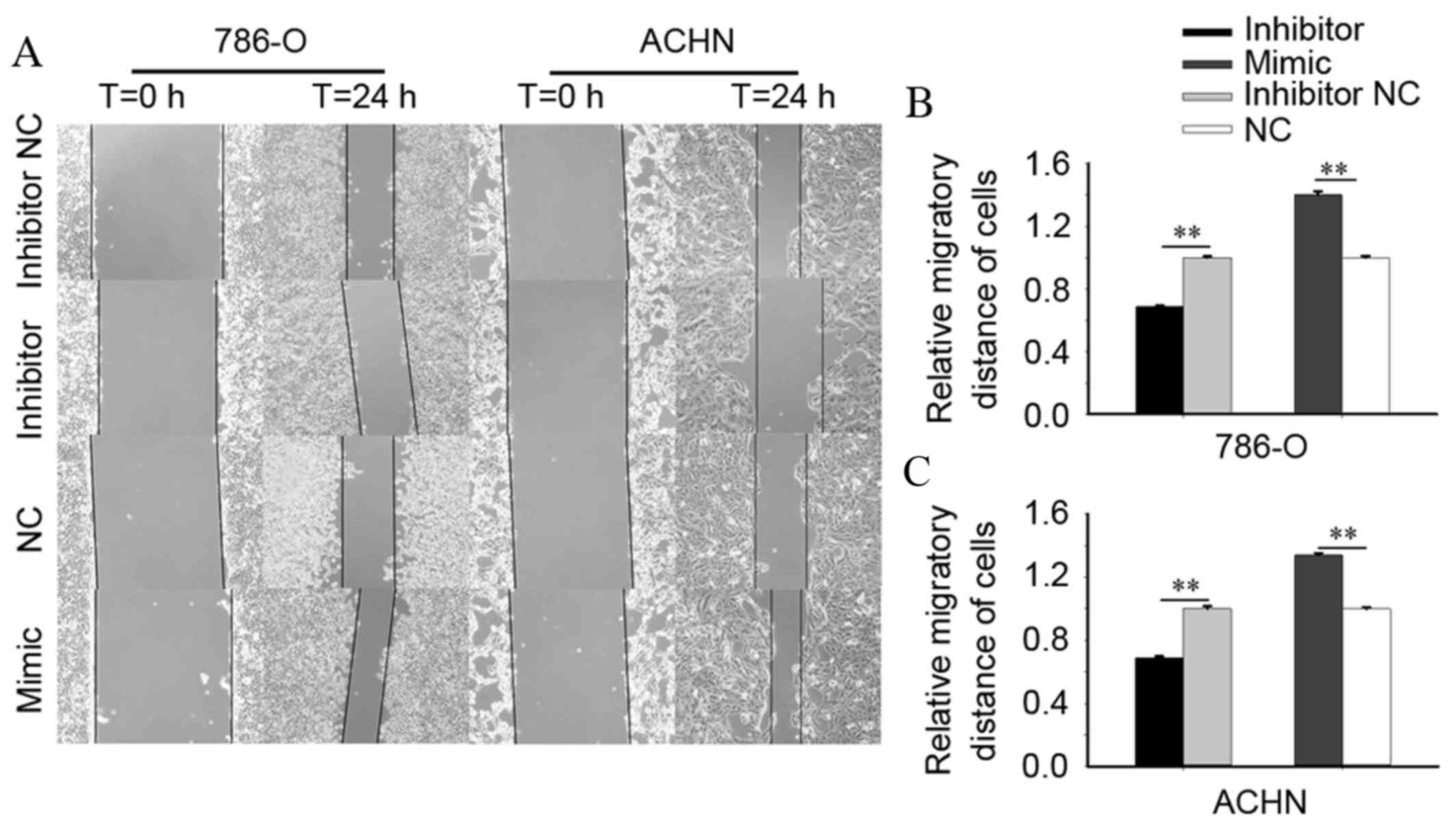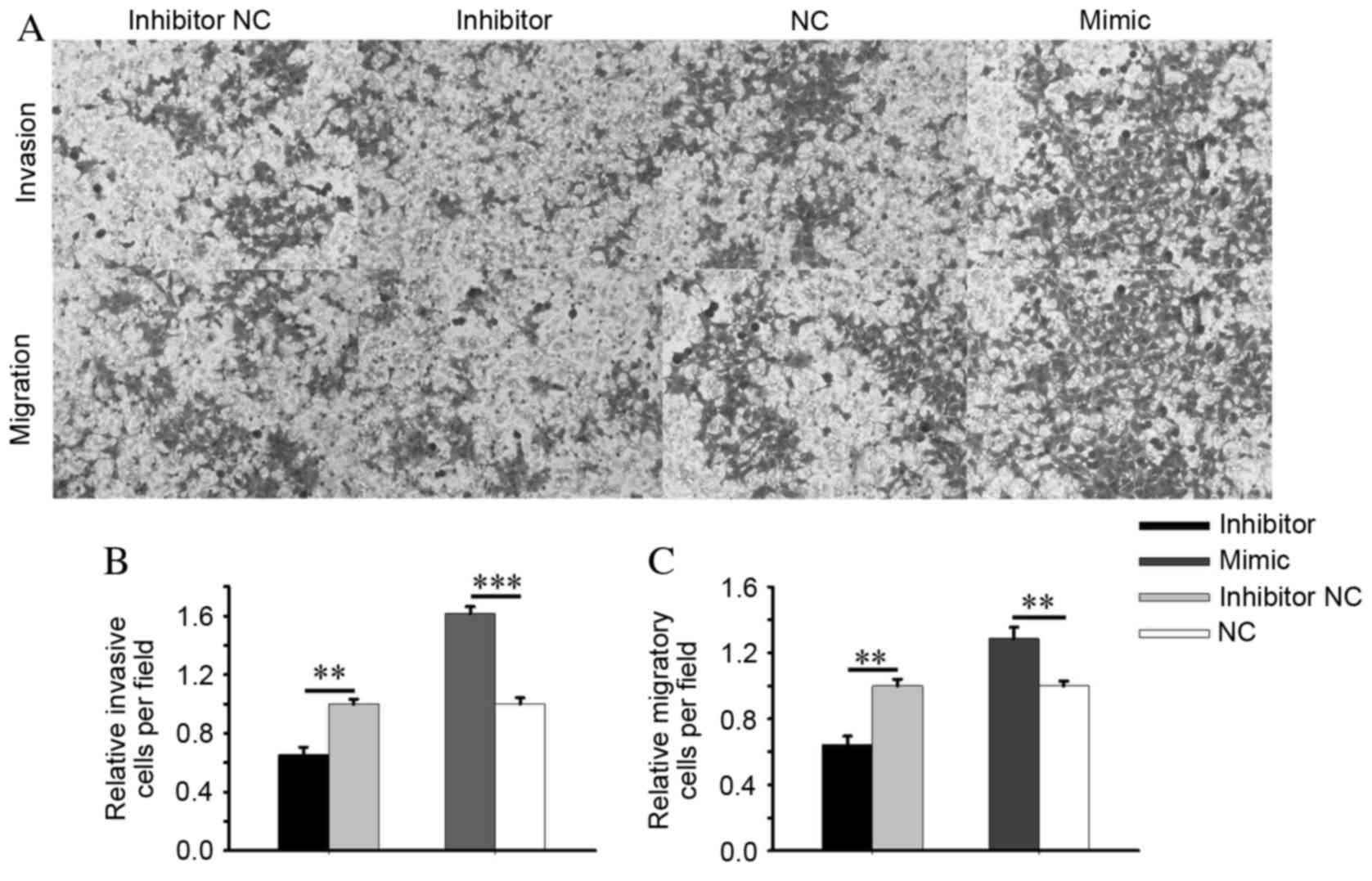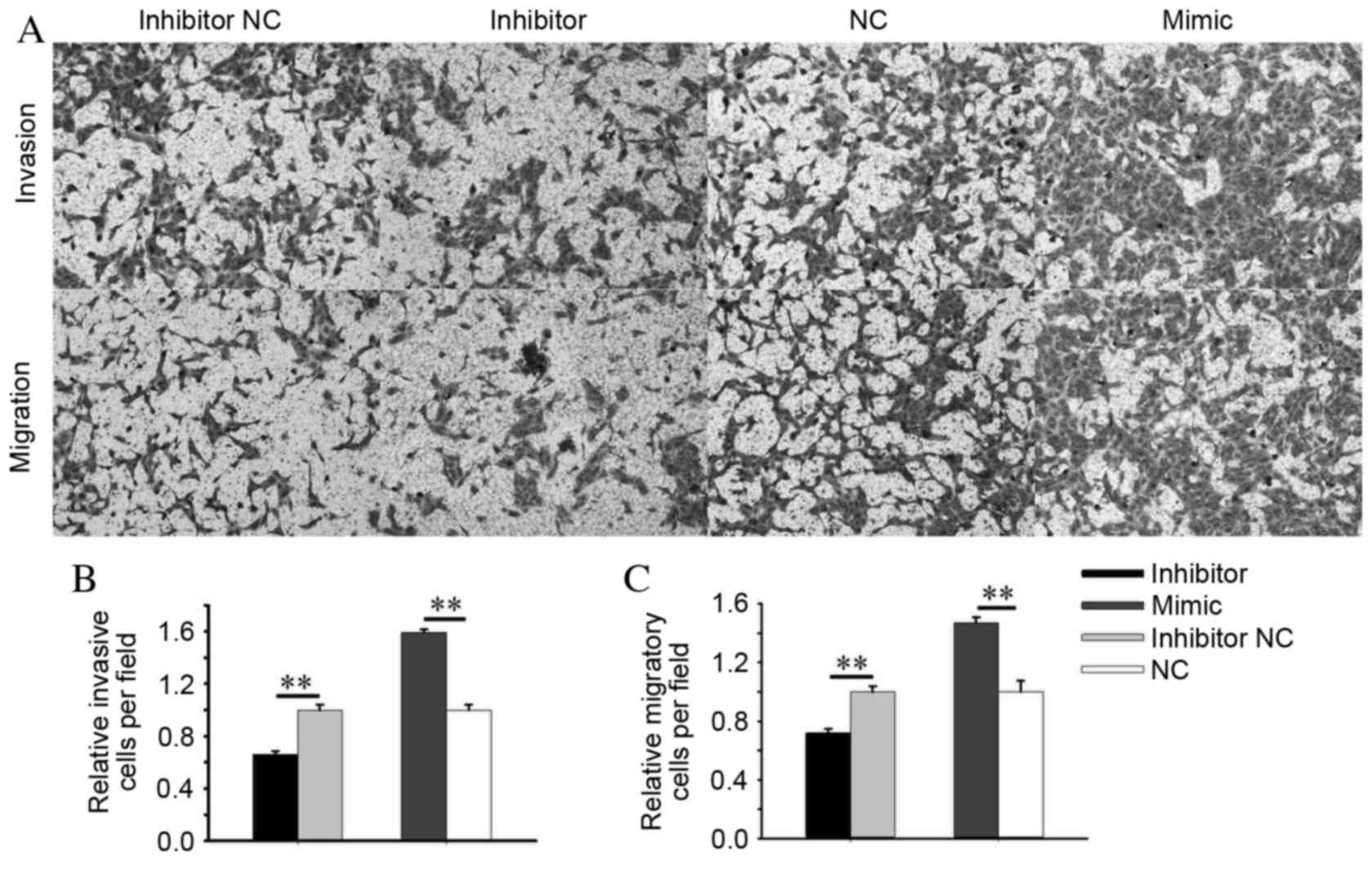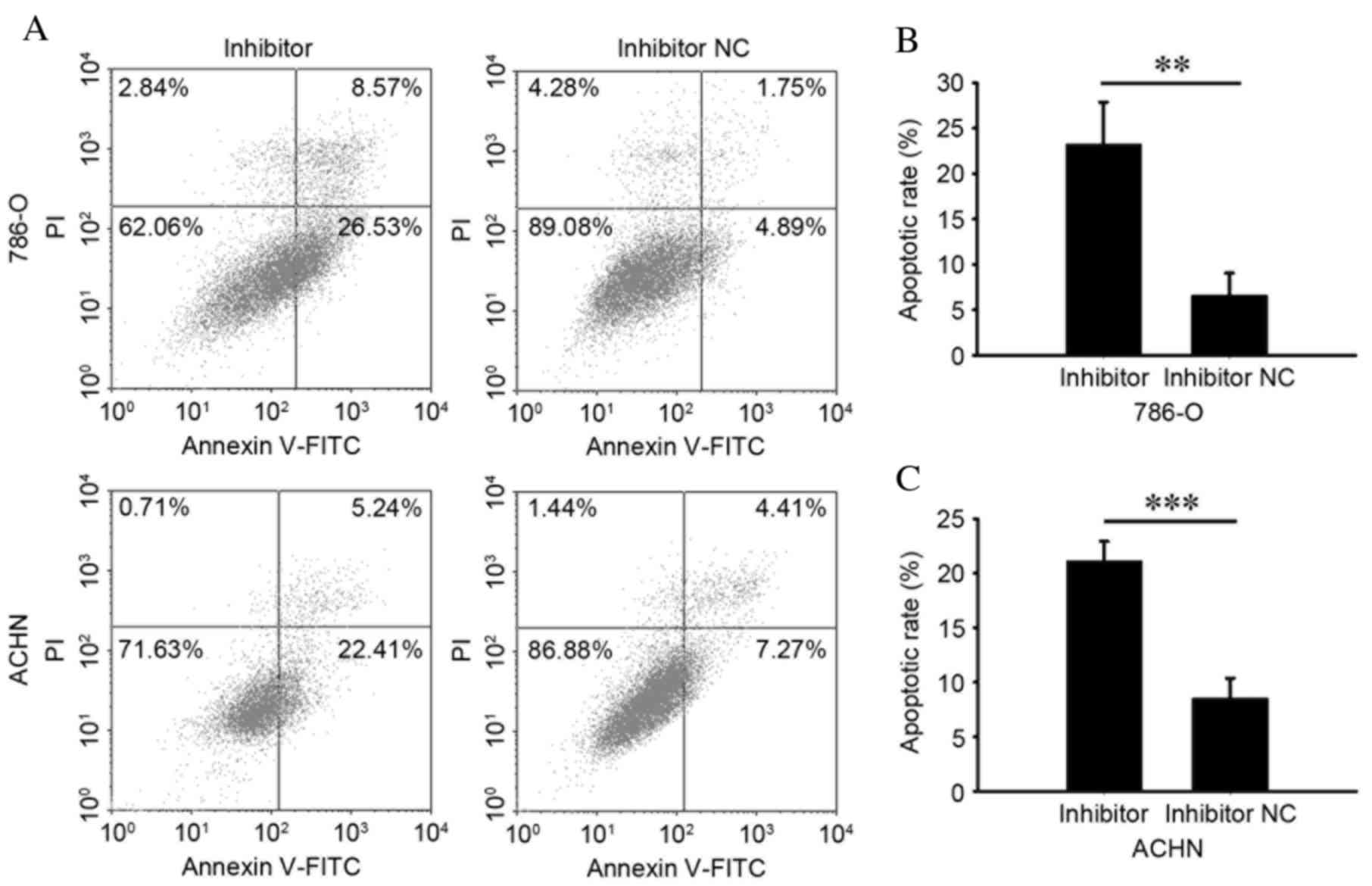MicroRNA‑24‑2 is associated with cell proliferation, invasion, migration and apoptosis in renal cell carcinoma
- Authors:
- Published online on: October 4, 2017 https://doi.org/10.3892/mmr.2017.7705
- Pages: 9157-9164
Abstract
Introduction
Renal cell carcinoma (RCC) accounts for ~3% of all adult malignancies and is the most common type of adult kidney cancer (1). The long-term prospects for patients with advanced RCC have improved; however, disease progression-free survival in the absence of debilitating side effects remains a work-in-progress (2). Various subtypes of RCC have been reported, with clear cell carcinoma and papillary RCC accounting for ~75 and ~10% of all RCC cases, respectively (2,3). Surgical treatment is effective for RCC; however, 20–40% of patients develop metastatic disease following surgery (4). Furthermore, the five-year survival rate of patients with distant metastasis remains <10% (5). Thus, it is important to identify novel diagnostic and prognostic biomarkers of RCC.
MicroRNAs (miRNAs), a type of small non-coding RNA, may regulate the translation of protein-coding genes by repressing translation of protein-coding mRNA or enhancing mRNA degradation by binding to the 3′ untranslated regions of mRNAs (6–8). miRNA (miR)-24 has been demonstrated to be downregulated in certain tumors, including breast carcinoma (9), osteosarcoma (10) and gastric cancer (11). Microarray analyses have revealed that miR-24 was upregulated in RCC (12). However, the expression levels of miR-24 in RCC remain to be verified by reverse transcription-quantitative polymerase chain reaction (RT-qPCR) in RCC tissues. In the present study, expressions levels of miR-24-1 and miR-24-2 (two stem-loops of miR-24-3p, the mature sequence of miR-24) were detected by RT-qPCR in RCC tissues paired with healthy control tissues and in RCC cell lines. Furthermore, the potential functions of miRNAs in RCC cell lines were investigated by cell proliferation, mobility and apoptosis assays.
Materials and methods
Collection of samples
A total of 35 paired tissues were collected from Peking University Shenzhen Hospital (Shenzhen, China). Written informed consent was obtained from all patients. The collection and use of the samples was reviewed and approved by the Ethics Committee of Peking University Shenzhen Hospital. The tissues were dissected, immersed in RNAlater (Qiagen GmbH, Hilden, Germany) for 30 min, and stored at −80°C. A pair of tissues included RCC tissue and adjacent healthy tissue that was 2 cm away from visible RCC lesions. The tissues collected were reviewed and classified by hematoxylin and eosin staining. The clinical and pathological characteristics of the patients are presented in Table I.
Cell culture
The present study used 293T human embryonic kidney (293T, Type Culture Collection of the Chinese Academy of Medical Sciences, Shanghai, China) and 786-O, ACHN and 769P RCC cell lines (American Type Culture Collection, Manassas, VA, USA). Cells were cultured in Dulbecco's modified Eagle's medium (Gibco; Thermo Fisher Scientific, Inc., Waltham, MA, USA) supplemented with 10% fetal bovine serum (FBS, Gibco, Thermo Fisher Scientific, Inc.), 1% antibiotics (100 µl/ml penicillin and 100 mg/ml streptomycin sulfates) and 1% glutamine, in a humidified incubator in 5% CO2 at 37°C.
RNA extraction, cDNA synthesis and RT-qPCR
Total RNA was extracted from tissues and cells using TRIzol® Reagent (Invitrogen; Thermo Fisher Scientific, Inc.) and purified with the RNeasy Maxi kit (Qiagen GmbH), according to the manufacturer's protocol. The concentration of RNA was measured using a NanoDrop 2000/2000c spectrophotometer (Thermo Fisher Scientific, Inc.). A total of 1 µg RNA from each sample was used for reverse transcription using the miScript RT kit (Qiagen GmbH), following the manufacturer's protocol to acquire cDNA. qPCR was performed to detect the expression levels of miR-24-1 and miR-24-2, using the miScript SYBR® Green PCR kit (Qiagen, Germany) and the Lightcycler 480® Real-Time PCR system (Roche Applied Science, Penzburg, Germany) according to the manufacturer's protocol. U6 served as the internal control. Primer sequences are presented in Table II. The universal primer, used as reverse primer of miR-24-2, was provided in the miScript SYBR Green PCR kit. The conditions of RT-qPCR were: 95°C for 1 min, then 95°C for 10 sec, 55°C for 30 sec, 70°C for 30 sec, for 40 cycles. The expression levels of miRNAs were analyzed using the 2−ΔΔCq method (13).
Cell transfection
To assess the expression levels of miR-24-2, a synthesized miR-24-2 mimic or inhibitor or their respective negative controls (NC; Shanghai GenePharma, Co., Ltd., Shanghai, China), at a concentration of 20 µmol/l, was transfected into cells using Lipofectamine® 2000 (Invitrogen; Thermo Fisher Scientific, Inc.), which was subsequently added to the Opti-Minimum Essential Medium® I Reduced Serum Medium (Gibco; Thermo Fisher Scientific, Inc.) and incubated for 24 h. Following this, qPCR was performed to verify alterations in miR-24-2 expression. The sequences are presented in Table II.
Wound scratch assay
A wound scratch assay was performed to assess the cell migration ability of 786-O and ACHN cells in vitro. Cells (~6×105 cells/well) were seeded into 6-well plates, incubated for 24 h and transfected with 200 pmol miR-24-2 mimic, inhibitor, NC or inhibitor NC. A vertical line was scratched with a sterile 200 µl pipette tip 6 h after transfection. The cells were rinsed with phosphate-buffered saline (PBS) to remove floating cells. A digital camera system was used to acquire images of the scratches at 0 and 24 h. The experiments were performed in triplicate and repeated at least three times.
Transwell assay
A Transwell assay was performed to assess the migration and invasion ability of 786-O and ACHN cells in vitro. Transwell chamber inserts (BD Biosciences, Franklin Lakes, NJ, USA) with or without Matrigel (BD Biosciences) were used for invasion and migration assays, respectively, according to the manufacturer's protocol. The transfected cells were seeded into the upper chamber at a density of 1×104 cells in 200 µl Dulbecco's Modified Eagle's medium (Gibco, Thermo Fisher Scientific, Inc.). Medium containing 10% FBS was added to the lower chamber. The cells were allowed to migrate for 36 h and invade for 48 h. The cells that had migrated or invaded to the bottom of the inserts were stained with crystal violet and counted using a microscope. The experiments were performed in triplicate and repeated at least three times.
3-(4,5-dimethylthiazol-2-yl)-2,5-diphenyltetrazolium bromide (MTT) assay
An MTT assay was performed to assess the proliferation of 786-O and ACHN cells in vitro. Cells (~3,000 cells/well) were seeded into a 96-well plate, and subsequently transfected with 5 pmol miR-24-2 mimic, inhibitor, NC or inhibitor NC. A total of 20 µl MTT (5 mg/ml; Sigma-Aldrich; Merck Millipore, Darmstadt, Germany) was added into the wells and incubated at 37°C for 4 h. Cell proliferation was assessed at 0, 24, 48 or 72 h post-transfection. Following this, the medium was replaced with 150 µl dimethyl sulfoxide (Sigma-Aldrich; Merck Millipore) and plates were agitated for 15 min at room temperature. The optical density (OD) of each well was subsequently measured at a wavelength of 490 nm using an ELISA microplate reader (Bio-Rad Laboratories, Inc., Hercules, CA, USA). The experiments were performed in triplicate and repeated at least three times.
Cell Counting kit-8 (CCK-8) assay
Proliferation of 786-O and ACHN cells was additionally assessed using the CCK-8 (Beyotime Institute of Biotechnology, Haimen, China), following the manufacturer's protocol. Into 96-well plates, ~4,000 cells were seeded per well, incubated for 24 h and transfected with 5 pmol miR-24-2 mimic, inhibitor, NC or inhibitor NC. After 0, 24, 48 or 72 h, 15 µl CCK-8 was added into each well and the plate was incubated for 1.5 h. Following this, the OD of each well was measured at a wavelength of 490 nm using an ELISA microplate reader. The experiments were performed in triplicate and repeated at least three times.
Flow cytometric analysis of apoptosis
Apoptosis of 786-O and ACHN cells was measured in vitro by flow cytometry. Cells were seeded at a density of ~3×105/well into 6-well plates and subsequently transfected with 200 pmol miR-24-2 mimic, inhibitor, NC or inhibitor NC. After 48 h, cells were harvested and washed twice with cold PBS. Cells were subsequently resuspended in 100 µl 1X binding buffer and 5 µl annexin V-fluorescein isothiocyanate, following which 3 µl propidium iodide (all from Invitrogen; Thermo Fisher Scientific, Inc.) was added into each cell suspension. A total of 15 min later, 400 µl binding buffer was added to each tube. A COULTER® EPICS® XL™ Flow Cytometer (Beckman Coulter, Inc., Brea, CA, USA) was subsequently used to analyze the apoptosis rate. FlowJo (version X) flow cytometry analysis software (FlowJo LLC, Ashland, OR) was used in the study.
Statistical analysis
A paired t-test was used to compare the expression levels of miR-24-2 in matched tissues. An unpaired Student's t-test was used to analyze assays characterizing the phenotypes of cells. All statistical analyses were performed using SPSS software version 19.0 (IBM SPSS, Armonk, NY, USA) and data are presented as the mean ± standard deviation. P<0.05 was considered to indicate a statistically significant difference.
Results
miR-24-2 is upregulated in RCC tissues and cell lines
The expression levels of miR-24-1 and miR-24-2 were determined by RT-qPCR in 35 RCC cell lines and paired healthy tissues. The expression levels of miR-24-1 in tissues and cells were reduced to the extent that miR-24-1 was detected in less than half of all tissues, and the majority of quantification cycle values were >36 (data not shown). The ratios of miR-24-2 in the 35 paired tissues [log2Ratio (T/N)] are presented in Fig. 1A; miR-24-2 was upregulated in 24 RCC tissues. The results demonstrated that the expression levels of miR-24-2 in RCC tissues (mean of relative expression, 3.88) were significantly increased compared with healthy tissues (P=0.004; Fig. 1B). In addition, expression levels of miR-24-2 in 786-O, ACHN and 769P RCC cell lines were significantly increased compared with the 293T human embryonic kidney cell line (P=0.009, 786-O; P=0.003, 769P; P=0.0002, ACHN; Fig. 1C). The results of the present study suggested that miR-24-2 is upregulated in RCC cell lines and tissues compared with healthy kidney cell lines or tissues. Therefore, miR-24-2, compared with miR-24-1, may function as an oncogene in RCC.
Validation of cell transfection efficiency
To quantify the expression levels of miR-24-2 following transfection of an miR-24-2 mimic, inhibitor, NC or inhibitor NC, RT-qPCR was performed. The expression levels of miR-24-2 in the miR-24-2 mimic group were 1,075.55- and 840.69-fold greater in the 786-O and ACHN groups, respectively, compared with the NC group (P=0.009, 786-O; P=0.004, ACHN). miR-24-2 expression levels in the inhibitor group were 0.25- and 0.22-fold greater in the 786-O and ACHN groups, respectively, compared with the inhibitor NC group (P=0.008, 786-O; P=0.005, ACHN; Fig.1D).
miR-24-2 promotes cell proliferation
MTT and CCK-8 assays were performed in vitro to detect cell proliferation. These results suggested that upregulation of miR-24-2 may mediate RCC cell proliferation, whereas downregulation of miR-24-2 may attenuate cell proliferation. An MTT assay revealed that proliferation of 786-O cells transfected with an miR-24-2 inhibitor was reduced by 5.62 (P=0.503), 7.45 (P=0.032) and 8.29% (P=0.012) at 24, 48 and 72 h, respectively, compared with the inhibitor NC group (Fig. 2A). Cell proliferation was increased in the mimic group by 7.27 (P=0.630), 14.42 (P=0.0091) and 27.07% (P=0.009) at 24, 48 and 72 h following transfection, respectively, compared with the NC group (Fig. 2B). A CCK-8 assay demonstrated that proliferation of 786-O cells in the inhibitor group was reduced by 7.15 (P=0.016) and 11.51% (P=0.002), compared with cells transfected with an inhibitor NC for 48 and 72 h, respectively (Fig. 2C). Cell proliferation was increased by 18.38 (P=0.019), 14.00 (P=0.046) and 14.96% (P=0.011) following transfection for 24, 48 and 72 h, respectively, compared with cells transfected with NC (Fig. 2D).
Similar results were observed in ACHN cells
As assessed by MTT assay, proliferation of cells transfected with an miR-24-2 inhibitor was reduced by 7.75% (P=0.011) 72 h after transfection (Fig. 3A). After 24, 48 and 72-h transfection, proliferation was reduced by 9.40 (P=0.035), 8.62 (P=0.034) and 13.06% (P=0.034) respectively, compared with the inhibitor NC group, as determined by a CCK-8 assay (Fig. 3B). Proliferation of ACHN cells in the miR-24-2 mimic group increased by 9.65 (P=0.040), 14.77 (P=0.003) and 10.17% (P=0.001; MTT assay; Fig. 3C), and 12.25 (P=0.015), 20.70 (P=0.020) and 19.03% (P=0.001; CCK-8 assay; Fig. 3D) 24, 48 and 72 h after transfection, respectively, compared with cells transfected with NC. Therefore, the upregulation of miR-24-2 expression levels may mediate RCC cell proliferation, whereas downregulation of miR-24-2 may inhibit cell proliferation.
miR-24-2 promotes RCC cell mobility
To investigate the effect of miR-24-2 on RCC cell mobility, Transwell and wound scratch assays were performed. As presented in Fig. 4A and B, the wound scratch assay of 786-O cells demonstrated that 24 h post-transfection, the migratory distance of cells transfected with an miR-24-2 inhibitor was reduced significantly by 31.43% (P=0.004), compared with cells transfected with an inhibitor NC. The upregulation of miR-24-2 increased cell migration by 40.05% (P=0.003) compared with the NC group. In ACHN cells, 24 h post-transfection, downregulation of miR-24-2 reduced the migratory distance by 31.23% (P=0.009), whereas upregulation of miR-24-2 using an miR-24-2 mimic increased migratory distances by 33.92% (P=0.002), compared with cells transfected with an inhibitor NC and NC, respectively (Fig. 4A and C).
The Transwell assay revealed that the invasiveness of 786-O cells transfected with an miR-24-2 inhibitor was reduced significantly by 34.58% compared with cells transfected with an inhibitor NC (P=0.001), and was markedly increased by 61.63% in the miR-24-2 mimic group, compared with the NC group (P=0.0004; Fig. 5A and B). The migration ability of 786-O cells transfected with miR-24-2 inhibitors was reduced by 35.53% (P=0.001) and increased by 28.57% (P=0.007) in cells transfected with an miR-24-2 mimic, compared with the inhibitor NC and NC groups, respectively (Fig. 5A and C). In ACHN cells, the invasiveness of cells transfected with an miR-24-2 inhibitor was reduced by 34.07% (P=0.009) and increased by 59.36% (P=0.003) in cells transfected with an miR-24-2 mimic compared with cells transfected with an inhibitor NC and NC, respectively (Fig. 6A and B). The migratory ability of cells was reduced by 28.05% (P=0.003) in the inhibitor group and increased by 47.26% (P=0.001) in the mimic group, compared with the inhibitor NC and NC groups, respectively (Fig. 6A and C). Therefore, miR-24-2 may mediate RCC cell mobility.
Knockdown of miR-24-2 induces apoptosis
To assess cell apoptosis following transfection, flow cytometry was performed. As presented in Fig. 7, the early apoptosis rate of cells transfected with an miR-24-2 inhibitor or inhibitor NC was 23.29 vs. 6.62% in 786O cells (P=0.003; Fig. 7A and B) and 21.18 vs. 8.56% in ACHN cells (P<0.001; Fig. 7A and C). However, no significant differences were observed between levels of apoptosis in cells transfected with an miR-24-2 mimic or NC (results not shown). These results demonstrated that knockdown of miR-24-2 may induce cell apoptosis.
Discussion
RCC, the most common type of kidney cancer, is a highly vascularized tumor originating from the renal cortex. The incidence of RCC is increasing at a rate of 2.6% annually (5,14). Traditional chemotherapy and radiotherapy have limited success in the treatment of advanced RCC (15), whereas surgical treatment has been demonstrated to be more effective. However, 20–40% patients develop metastatic disease following surgery (4). miRNAs may provide novel strategies for the diagnosis, prognosis and development of therapeutic applications for RCC.
miR-24-1 and miR-24-2 are two members of the miR-24 family, which possess different stem-loops. The present study detected the expression levels of miR-24-1 and miR-24-2 by RT-qPCR. The results indicated that miR-24-1 was almost absent in the majority of RCC and paired healthy tissues, whereas miR-24-2 was upregulated in RCC tissues and cell lines, compared with paired healthy tissues and the HEK-293T cell line, respectively. A synthesized miR-24-2 mimic, inhibitor, NC or inhibitor NC was transfected into 786-O and ACHN RCC cells to investigate the role of miR-24-2 in RCC tumorigenesis. The results demonstrated that upregulation of miR-24-2 may promote RCC cell proliferation, migration and invasion, whereas downregulation may inhibit these processes. Furthermore, downregulation may induce RCC cell apoptosis. Therefore, miR-24-2 may be involved in RCC tumorigenesis and development. Additionally, the present study identified miR-24-2 as an oncogene in RCC, which is in contrast to previous studies (10,11).
miR-24-2 is a member of miR-23a/-27a/-24-2 cluster, which exists intergenically in the vertebrate genome (6). Srivastava et al (16) demonstrated that miR-24-2 may regulate H2A histone family member X gene expression and induce MCF-7 breast cancer cell apoptosis by targeting B-cell lymphoma 2. A subsequent study by the same group revealed that these effects may be enhanced following treatment with 2 nM docetaxel (17). A previous study identified that overexpression of miR-24-2 may suppress MCF-7 cell survival by targeting protein kinase C α (18). Therefore, miR-24-2 may serve a role as a tumor suppressor in breast cancer and is a potential target for the treatment of breast cancer.
The miR-23a/-27a/-24-2 cluster has been demonstrated to be associated with apoptosis of human embryonic kidney cells. Chhabra et al (19) demonstrated that the miR-23a/-27a/-24-2 cluster induces apoptosis in HEK-293T cells via c-Jun N-terminal kinases. Apoptosis in HEK-293T cells induced by the cluster was revealed to be associated with the endoplasmic reticulum stress and unfolded protein response signaling pathways (20). The miR-23a/-27a/-24-2 cluster was additionally demonstrated to be regulated by macrophage M1 and M2 cytokines, and may in turn regulate M1 and M2 polarization via a negative feedback loop. Furthermore, macrophages overexpressing the miR-23a/-27a/-24-2 cluster exhibited antitumor effects (21). Notably, in the present study, knockdown of miR-24-2, a member of the cluster, was revealed to induce RCC cell apoptosis. Overexpression of miR-27a, another member of the cluster, has previously been demonstrated to mediate RCC cell migration, invasion and proliferation (22,23). Based on previous studies, two members of the miR-23a/-27a/-24-2 cluster, miR-27a and −24-2, may act as oncogenes in RCC.
In conclusion, the results of the present study identified miR-24-2 as an oncogene associated with cell proliferation, migration, invasion and apoptosis in RCC, which indicated that miR-24-2 may be involved in RCC tumorigenesis and development. Further studies are required to investigate the signaling pathways of miR-24-2, and the potential of miR-24-2 as a therapeutic target or biomarker for the early detection of RCC.
Acknowledgements
The present study was supported by the National Natural Science Foundation of China (grant no. 81101922), the Science and Technology Development Fund Project of Shenzhen (grant nos. JCYJ20150403091443329 and JCYJ20170307111334308), the fund of ‘San-ming’ Project of Medicine in Shenzhen (2017) and the fund of Guangdong Key Medical Subject (2015).
References
|
Chen D, Li Y, Su Z, Yu Z, Yu W, Li Y, Gui Y, Yang S and Lai Y: Identification of miR-125a-5p as a tumor suppressor of renal cell carcinoma, regulating cellular proliferation, migration and apoptosis. Mol Med Rep. 11:1278–1283. 2015. View Article : Google Scholar : PubMed/NCBI | |
|
Sellitti DF and Doi SQ: MicroRNAs in renal cell carcinoma. Microrna. 4:26–35. 2015. View Article : Google Scholar : PubMed/NCBI | |
|
Zhang HM, Yang FQ, Chen SJ, Che J and Zheng JH: Upregulation of long non-coding RNA MALAT1 correlates with tumor progression and poor prognosis in clear cell renal cell carcinoma. Tumour Biol. 36:2947–2955. 2015. View Article : Google Scholar : PubMed/NCBI | |
|
Xu M, Gu M, Zhang K, Zhou J, Wang Z and Da J: miR-203 inhibition of renal cancer cell proliferation, migration and invasion by targeting of FGF2. Diagn Pathol. 10:242015. View Article : Google Scholar : PubMed/NCBI | |
|
Yan Y, Yang FQ, Zhang HM, Che J and Zheng JH: Up-regulation of flotillin-2 is associated with renal cell carcinoma progression. Tumour Biol. 35:10479–10486. 2014. View Article : Google Scholar : PubMed/NCBI | |
|
Li X, Liu X, Xu W, Zhou P, Gao P, Jiang S, Lobie PE and Zhu T: c-MYC-regulated miR-23a/24-2/27a cluster promotes mammary carcinoma cell invasion and hepatic metastasis by targeting Sprouty2. J Biol Chem. 288:18121–18133. 2013. View Article : Google Scholar : PubMed/NCBI | |
|
Li Y, Tang W, Zhang LR and Zhang CY: FMRP regulates miR196a-mediated repression of HOXB8 via interaction with the AGO2 MID domain. Mol Biosyst. 10:1757–1764. 2014. View Article : Google Scholar : PubMed/NCBI | |
|
Wang BS, Liu Z, Xu WX and Sun SL: Functional polymorphisms in microRNAs and susceptibility to liver cancer: A meta-analysis and meta-regression. Genet Mol Res. 13:5426–5440. 2014. View Article : Google Scholar : PubMed/NCBI | |
|
Du WW, Fang L, Li M, Yang X, Liang Y, Peng C, Qian W, O'Malley YQ, Askeland RW, Sugg SL, et al: MicroRNA miR-24 enhances tumor invasion and metastasis by targeting PTPN9 and PTPRF to promote EGF signaling. J Cell Sci. 126:1440–1453. 2013. View Article : Google Scholar : PubMed/NCBI | |
|
Song L, Yang J, Duan P, Xu J, Luo X, Luo F, Zhang Z, Hou T, Liu B and Zhou Q: MicroRNA-24 inhibits osteosarcoma cell proliferation both in vitro and in vivo by targeting LPAATβ. Arch Biochem Biophys. 535:128–135. 2013. View Article : Google Scholar : PubMed/NCBI | |
|
Duan Y, Hu L, Liu B, Yu B, Li J, Yan M, Yu Y, Li C, Su L, Zhu Z, et al: Tumor suppressor miR-24 restrains gastric cancer progression by downregulating RegIV. Mol Cancer. 13:1272014. View Article : Google Scholar : PubMed/NCBI | |
|
Huang Y, Dai Y, Yang J, Chen T, Yin Y, Tang M, Hu C and Zhang L: Microarray analysis of microRNA expression in renal clear cell carcinoma. Eur J Surg Oncol. 35:1119–1123. 2009. View Article : Google Scholar : PubMed/NCBI | |
|
Livak KJ and Schmittgen TD: Analysis of relative gene expression data using real-time quantitative PCR and the 2(-Delta Delta C(T)) method. Methods. 25:402–408. 2001. View Article : Google Scholar : PubMed/NCBI | |
|
Yu Z, Ni L, Chen D, Su Z, Yu W, Zhang Q, Wang Y, Li C, Gui Y and Lai Y: Expression and clinical significance of RCDG1 in renal cell carcinoma: A novel renal cancerassociated gene. Mol Med Rep. 10:1583–1589. 2014. View Article : Google Scholar : PubMed/NCBI | |
|
Zhai Q, Zhou L, Zhao C, Wan J, Yu Z, Guo X, Qin J, Chen J and Lu R: Identification of miR-508-3p and miR-509-3p that are associated with cell invasion and migration and involved in the apoptosis of renal cell carcinoma. Biochem Biophys Res Commun. 419:621–626. 2012. View Article : Google Scholar : PubMed/NCBI | |
|
Srivastava N, Manvati S, Srivastava A, Pal R, Kalaiarasan P, Chattopadhyay S, Gochhait S, Dua R and Bamezai RN: miR-24-2 controls H2AFX expression regardless of gene copy number alteration and induces apoptosis by targeting antiapoptotic gene BCL-2: A potential for therapeutic intervention. Breast Cancer Res. 13:R392011. View Article : Google Scholar : PubMed/NCBI | |
|
Manvati S, Mangalhara KC, Kalaiarasan P, Srivastava N and Bamezai RN: miR-24-2 regulates genes in survival pathway and demonstrates potential in reducing cellular viability in combination with docetaxel. Gene. 567:217–224. 2015. View Article : Google Scholar : PubMed/NCBI | |
|
Martin EC, Elliott S, Rhodes LV, Antoon JW, Fewell C, Zhu Y, Driver JL, Jodari-Karimi M, Taylor CW, Flemington EK, et al: Preferential star strand biogenesis of pre-miR-24-2 targets PKC-alpha and suppresses cell survival in MCF-7 breast cancer cells. Mol Carcinog. 53:38–48. 2014. View Article : Google Scholar : PubMed/NCBI | |
|
Chhabra R, Dubey R and Saini N: Gene expression profiling indicate role of ER stress in miR-23a~27a~24-2 cluster induced apoptosis in HEK293T cells. RNA Biol. 8:648–664. 2011. View Article : Google Scholar : PubMed/NCBI | |
|
Chhabra R, Adlakha YK, Hariharan M, Scaria V and Saini N: Upregulation of miR-23a-27a-24-2 cluster induces caspase-dependent and -independent apoptosis in human embryonic kidney cells. PLoS One. 4:e58482009. View Article : Google Scholar : PubMed/NCBI | |
|
Ma S, Liu M, Xu Z, Li Y, Guo H, Ge Y, Liu Y, Zheng D and Shi J: A double feedback loop mediated by microRNA-23a/27a/24-2 regulates M1 versus M2 macrophage polarization and thus regulates cancer progression. Oncotarget. 22:13502–13519. 2016. View Article : Google Scholar | |
|
Peng H, Wang X, Zhang P, Sun T, Ren X and Xia Z: miR-27a promotes cell proliferation and metastasis in renal cell carcinoma. Int J Clin Exp Pathol. 8:2259–2266. 2015.PubMed/NCBI | |
|
Nakata W, Uemura M, Sato M, Fujita K, Jingushi K, Ueda Y, Kitae K, Tsujikawa K and Nonomura N: Expression of miR-27a-3p is an independent predictive factor for recurrence in clear cell renal cell carcinoma. Oncotarget. 6:21645–21654. 2015. View Article : Google Scholar : PubMed/NCBI |



